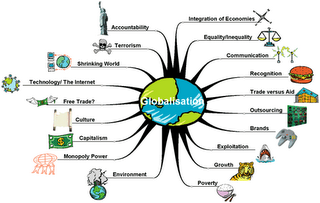Globalisation
Media organisations are growing more and more popular which means they are able to expand globally. This means that media organisations are able to reach out to a much wider audience then they did being national. The advanced telecommunications means that all cultural traditions are mergeing into a global culture and new media and genres are being developed.
New technologies allow us to interact differently and more efficiently with other people and also businesses.
As the media and technology evolves and converge this will lead to us being able to access all forms of media through one device. With new devices we are able to access a range of media through these devices.
All the large media organisations are supplying more of the media we consume. Our cultural perceptions are primarily constructed by the media so we recieve the values and ideologies they establish. This is called cultural homogenisation. (checkpoint 1)
Critics of this dominance refer to it as cultural imperialism. They argue that the US media dominates the values and ideologies forced upon us through the media. This is damaging tor media organisations. (checkpoint 2)
Some critics argue that the news we get is meddled with to best suit their conceptions of domestic needs. Others argue that the US monopolises the global information system.
Marshall McLuhan stated in the 60's that the world had become a global village. The media play a vital role in this. Many people around the world can share the same moment due to the media. Critics argue that the media reflects and creates the social and cultural world we live in as they construct our views of global events. Reception theory contradicts this. (checkpoint 3)

New technologies allow us to interact differently and more efficiently with other people and also businesses.
As the media and technology evolves and converge this will lead to us being able to access all forms of media through one device. With new devices we are able to access a range of media through these devices.
All the large media organisations are supplying more of the media we consume. Our cultural perceptions are primarily constructed by the media so we recieve the values and ideologies they establish. This is called cultural homogenisation. (checkpoint 1)
Critics of this dominance refer to it as cultural imperialism. They argue that the US media dominates the values and ideologies forced upon us through the media. This is damaging tor media organisations. (checkpoint 2)
Some critics argue that the news we get is meddled with to best suit their conceptions of domestic needs. Others argue that the US monopolises the global information system.
Marshall McLuhan stated in the 60's that the world had become a global village. The media play a vital role in this. Many people around the world can share the same moment due to the media. Critics argue that the media reflects and creates the social and cultural world we live in as they construct our views of global events. Reception theory contradicts this. (checkpoint 3)
